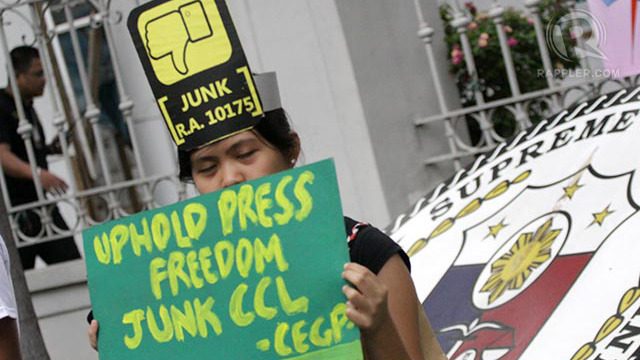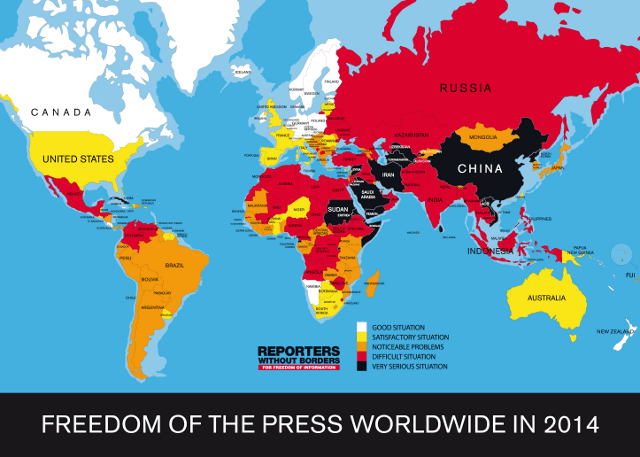SUMMARY
This is AI generated summarization, which may have errors. For context, always refer to the full article.

MANILA, Philippines – The Philippines is regarded as having one of the world’s freest media, as the 1987 Constitution guarantees the freedom of the press.
But some media practitioners remain at risk, having to face various threats from subjects they write about and criticize. It comes with the territory.
Cases of slain journalists have increased through the years, many of them still unsolved.
Also, access to public documents, through the Freedom of Information Bill (FOI), has remained difficult as Congress has yet to approve the law.
As we celebrate this year’s World Press Freedom Day on Saturday, May 3, let’s look at how some organizations assess the Philippine media, and how it compares to those in other countries.

1. Global Impunity Index
The Global Impunity Index is an annual report of the Committee to Protect Journalists (CPJ) which highlights “countries where journalists are slain and the killers go free.”
It ranks countries based on danger to journalists, based on the number of slain practitioners and based on how fast the cases are solved.
The Philippines ranked in CPJ’s 2014 report as the 3rd most dangerous place for journalists – a ranking that the country holds for the 4th consecutive year – with 0.527 unsolved journalist murders per million inhabitants.
Here’s the Philippine ranking in CPJ’s annual reports. Click on the years below to see the group’s report.
| Year | Rank | Unsolved journalist murders per million inhabitants |
| 2014 | 3rd | 0.527 |
| 2013 | 3rd | 0.580 |
| 2012 | 3rd | 0.589 |
| 2011 | 3rd | 0.609 |
| 2010 | 3rd | 0.609 |
| 2009 | 6th | 0.273 |
| 2008 | 6th | 0.289 |
2. Freedom of the Press Score
The US-based organization Freedom House released it annual Freedom of the Press report, where the level of media freedom and editorial independence of each country are measured.
Each of the countries are slotted in 3 categories: free, partly free, and not free.
From 2004 to 2014, the Philippines was labeled “partly free.”
For this year, the country was given a score of 44. The lower the score, the better the status is of the nation’s press freedom.
Freedom House hasn’t provided yet a description of the Philippine media in its latest report. But in its report last year, the organization described it as “largely stable…despite continued inertia in dealing with the ongoing issue of impunity in cases of violence against journalists, as well as the introduction of potentially restrictive Internet legislation.”
Here’s the annual Philippine score given by Freedom House. Click on the years below to see the group’s report.
| Year | Score | Classification |
| 2014 | 44 | partly free |
| 2013 | 43 | partly free |
| 2012 | 42 | partly free |
| 2011 | 46 | partly free |
| 2010 | 48 | partly free |
| 2009 | 45 | partly free |
| 2008 | 45 | partly free |
| 2007 | 46 | partly free |
| 2006 | 40 | partly free |
| 2005 | 35 | partly free |
| 2004 | 34 | partly free |
| 2003 | 30 | free |
| 2002 | 30 | free |
3. World Press Freedom Index
The World Press Freedom Index is annually published by Reporters Without Borders, a France-based organization.
This index ranks countries based on their press freedom records.
In its 2010 report, the group began categorizing countries into 5 stages, depending on the status of the country’s media: good situation, satisfactory situation, noticeable problems, difficult situation, very serious situation.
From 2010 up to 2014, Philippine media was put under the “difficult situation” category.
The group didn’t describe the Philippine media in its 2014 report. The country was last mentioned in the 2010 report, as its score increased significantly due to the Maguindanao massacre in 2009.
A lower score in the index corresponds to greater press freedom.
Here’s the score and ranking of the country through the years. Click on the years below to see the group’s report.
| Year | Rank | Score |
| 2014 | 149 | 43.69 |
| 2013 | 147 | 43.11 |
| 2011-2012 | 140 | 64.5 |
| 2010 | 156 | 60 |
| 2009 | 122 | 38.25 |
| 2008 | 139 | 45 |
| 2007 | 128 | 44.75 |
| 2006 | 142 | 51 |
| 2005 | 139 | 50 |
| 2004 | 111 | 36.63 |
| 2003 | 118 | 35.25 |
| 2002 | 89 | 29 |
– Rappler.com
Add a comment
How does this make you feel?



There are no comments yet. Add your comment to start the conversation.